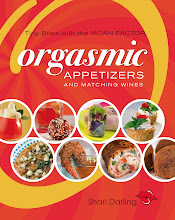 Chinese Meatball Recipe Below
Chinese Meatball Recipe BelowEvery culture has its own traditional meatball.
I have a fettish for meatballs of every kind. I love them in soups, sauces, and salads. I'll eat a giant meatball from the deli counter at my local supermarket as my lunch. I also serve them as hors d'oeuvres.
There is a mastery to making the perfect meatball.
The first secret to the perfect Italian meatball is to use a combination of pork, veal and beef. Veal adds the richness, while pork provides flavour and beef gives structure to the meatball. Add freshly grated parmesan cheese, fresh oregano and fresh parsley with this mixture. If you substitute with inferior ingrediens, you'll end up with a mediocre meatball.
The second secret is to ensure you do not overwook the mix. Warming up the mixture smears the fat throughout and make the meatballs tough.
Third...keep added ingredients cold, as well. If you're adding sauted mushrooms or carmelized onions to your meatball cool them down first.
Whenever using dried breadcrumbs, soak them in milk or heavy cream first. This keeps them moist and light. Or use fresh breadcrumbs with a little egg to make them tight.
The fifth secret is to consider how you cook the meatballs. Searing or braising them renders the fat from the balls into the sauce. This makes the dish high in fat, thus highly flavourful.
But if you're interested in eating more healthily, render the fat from the balls and sauce. Roast the balls first and then remove the fat. Or poach the meatballs for the same reason.
Lastly, be sure to cook your meatballs completely to avoid the potential of food born illnesses.
In Asian and Thai cuisine, for example, fish and seafood balls are popular. Ground crab, scallops and/or shrimp work nicely with cilantro, cumin, lemon and garlic, to name a few. These combinations also work with a white wine possessing good acidity called Sauvignon Blanc. The wine is delicious on hot, summer days. Its grassy, grapefruit, fig, green herb and bell pepper aromas and flavours complement meatballs that combine some of these ground meats and herbs and spices. The key is to experiment.
Other seafood balls, made of ground fish, such as salmon, or lobster, shrimp, chicken, pork, veal or turkey combined with chervil, fennel seed, fresh sage, garlic, curry, ginger, tarragon, and basil go nicely with a white called Chardonnay. Barrel fermented Chardonnay is known for its full-body and tropical aromas and flavours and buttery texture. This makes it an ideal sparing partner for all these ground meats.
Meatballs can also be made from the ground meat of smoked chicken, smoked duck, and smoked turkey, all of which complement rose. Most roses with a hint of sweetness work with the herbs and spices found in Mexican, Middle Eastern, Chinese, Thai, Cajun, Southwestern and Indonesian cuisines. Some of the herbs and spices in these multicultural cuisines are allspice, caraway, cayenne, cinnamon, clove, coriander, ginger and nutmeg.
Beef meatballs combined with the flavours of basil, bay leaves, clove, garlic, lavender and thyme go nicely with a light, fruity red wine called Pinot Noir. Pinot Noir often is medium bodied with aromas and flavours of black cherry, berries, cloves, violets and sometimes with smokiness. The idea is to choose a specific type of ground meat, choose a couple of spices and marry this to a specific wine. You wouldn’t want to go overboard with too many herbs and spices in one meatball. Simplicity is key.
Lamb, wild game, beef and duck meatballs are often incorporated into North American and Italian cuisines. Black pepper, garlic, lavender, mustard, rosemary, and thyme are all flavouring agents that partner well with Cabernet Sauvignon. Cabernet Sauvignon is a big, full-bodied red wine with black currant, cassis, eucalyptus, mint, berry, chocolate, cedar and tobacco like character.
One of my favourite red wines is Zinfandel. It possesses wild blackberries, raspberries, black pepper, chocolate and sometimes violet notes in the aromas and flavours. This big red is an ideal partner for spaghetti and meatballs. The herbs and spices of basil, bay leaves, and oregano are perfect complements for this grape variety. Zinfandel also complements many Italian, Creole and Southwestern dishes, all of which highlight meatballs, as well.
So, the next time you’re in the mood for meatballs, remember that there’s a wide range of ground meats, along with combinations of herbs and spices and wine partnerships from which to choose.
Here's three meatball recipes and matching wine notes to consider:
Chinese Rice–Studded Meatballs
Serves 4These rice-coated meatballs are known as zhen zhu or “pearls” in Chinese. Steaming the meatballs on bok choy leaves helps to keep them from sticking to the steamer. While this dish can be served as an appetizer, my husband likes it as an entrée.
1 cup jasmine rice (or rice of choice) 250 mL
2 to 4 outer bok choy leaves 2 to 4
4 scallions 4
1 egg 1
1/2 cup diced water chestnuts 125 mL
1 Tbsp each cornstarch, rice vinegar and sesame oil 15 mL
1 tsp sugar 5 mL
1/2 tsp chili paste 2 mL (or as desired)
1 lb ground chicken 500 g
Salt and pepper to taste
Bok choy leaves (for garnish)
Dipping Sauce: (Chinese Plum Sauce with added fresh lime
juice and splash of hotsauce)
Place rice in a bowl. Cover with hot water and soak until needed. Set a skillet filled with water on the stove and place a bamboo or metal steamer on the skillet. Line the steamer with bok choy leaves.
In a food processor or blender, add scallions, egg, water chestnuts, cornstarch, rice vinegar, sesame oil, sugar and chili paste. Puree, then transfer mixture to a bowl. Add ground chicken and season with salt and pepper. Mix well. Roll mixture into balls. Drain rice and transfer to a shallow dish. Coat meatballs with damp rice.
Bring the water in the skillet to a boil. Place batches of meatballs in steamer and steam until chicken is cooked through, about 25 minutes. Insert a toothpick in each meatball and place on a platter lined with bok choy leaves. Serve with dipping sauce.
Wine Suggestion: Sparkling Wine with Hint of SweetnessThe predominant building block is hot and spiciness from the dipping sauce, so the recipe requires a demi-sec sparkling wine with sweetness to offset the heat and spice.
Blue Cheese MeatballsServes Four
1 ½ lbs ground lean beef
1 ½ tsp salt
1 small garlic clove, minced
1 large egg
¼ lb blue cheese, cubed
Flour (for drudging)
4 tbsp butter
1 cup Cabernet Franc
Put meat in mixing bowl and mix thoroughly with salt crushed with minced garlic; blend in egg. Shape pieces of meat around each cube of cheese, and then roll each meatball lightly in flour. Heat butter in skillet and sauté meatballs, turning frequently until well browned. Add wine and simmer, covered, about 10 minutes.
Wine Suggestion: Cabernet FrancThis recipe calls for a big red with plenty of flavour to stand up to blue cheese and texture of meat.
Spicy Shrimp BallsServes 4
1 lb shrimp
4 shallots
4 cloves garlic
1 stalk lemon grass, bruised and chopped*
4 coriander roots*
10 pepper corns (1/4 tsp cracked black pepper)
1 small piece krachai root (about 1 tbsp chopped)*
½ tsp grated wild lime (makrood) peel (lime peel may be substituted)*
5-10 dried chillies or to taste
1 tbsp shrimp paste
1 tbsp fish sauce or to taste
8 oz green beans, thinly sliced in rounds
1 egg beaten
2-3 cups vegetable oil for deep-frying
*lemon grass, coriander roots, krachai and makrood are available in asian supermarkets
Peel and devein shrimp; puree or grind. In a mortar, pound together shallots, garlic, lemon grass, coriander roots, peppercorns, krachai, wild lime peel and chillies. Gradually blend in shrimp paste and fish sauce as the ingredients start to break down. When consistency of a fairly smooth paste, mix in shrimp puree, green beans and egg. Roll into small balls. Heat oil in heavy pot or deep-fry balls over medium heat about 4 minutes or until golden.
Wine Suggestion: Semi Dry VidalWhen entertaining, begin with an easy drinking wine to pair with the appetizers. Let the quality of the wines served increase in weight, structure and flavour as the evening progresses. Semi Dry Vidal offers enough sweetness to counteract the Thai spiciness in this appetizer. It is also light body and so doesn’t overpower the delicate nature of shrimp.





























